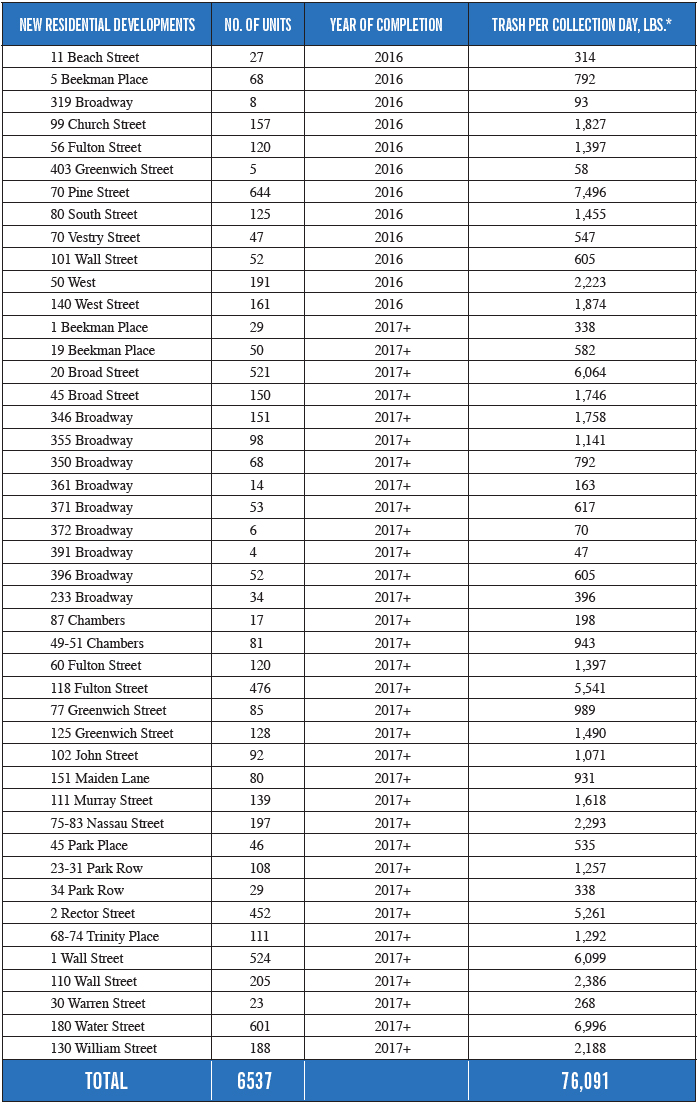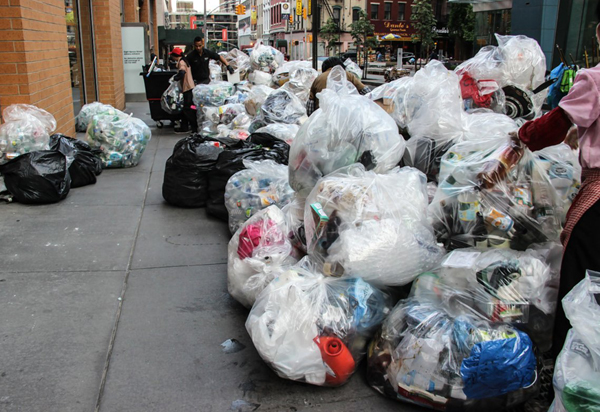
Residential buildings such as the Frank Gehry-designed, 900-unit tower at 8 Spruce St. are free to put their garbage and recycling out on the sidewalk the day before scheduled collection any time after 4 p.m. — just in time for rush hour.
BY BILL EGBERT
The residential boom transforming Downtown is still going strong, and has already attracted eagerly anticipated retail and dining options to once-barren neighborhoods. But the thousands of new units coming to the area are also bringing something much less desirable in their wake — several tons more household garbage every day.
Based on the upcoming developments already announced, the amount of household trash coming to Downtown is set to surge more in just the next three years than it has over the past five.
And neighbors say the towers of trash bags piling up on the sidewalks are already seriously affecting their quality of life.
“There is so much more garbage now,” said Sarah Elbatanouny, who has lived in Fidi for the past 12 years. “I feel sorry for parents with strollers. Sometimes the only way for them to get past is to walk in the street.”
Lower Manhattan has one of the fastest growing residential populations in the city, and definitely has the fastest growing burden of household garbage. Between 2010 and 2015, the amount of residential trash picked up each day across the entire borough of Manhattan rose by 28.6 tons, according to city figures, and nearly half of that increase — 13.6 tons — was all within Community District 1.
That dramatic spike in Downtown detritus came from the estimated 4,623 new residential units added to the area since 2010.
As the residential boom gathered pace, so did complaints to 311 about the household garbage and recycling piling up on the sidewalk for collection.
The city complaint hotline received 10 calls from CB1 residents in 2011, but that number more than doubled by 2014 to 23 garbage-related complaints, according to the city. More recently, complaints have dropped significantly — from 22 calls in 2015 down to just two complaints so far this year — due in part to more aggressive enforcement of the rules on putting out trash, but also educating locals as to what actually constitutes a violation.
At a meeting of CB1’s Quality of Life Committee last November, Dept. of Sanitation community officer Iggy Terranova pointed out that it’s perfectly legal for residential buildings to put their trash out on the sidewalk any time after 4 p.m. — just in time for rush hour — on the day before it is collected.
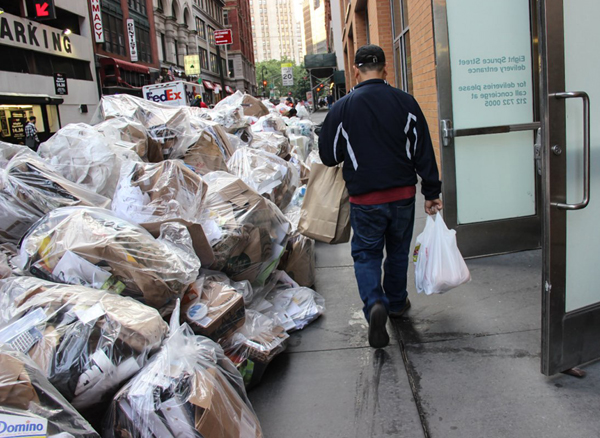
Downtowners complain that sharing the area’s narrow sidewalks with growing piles of refuse is hurting their quality of life.
So a block-long, five-foot-tall wall of leaky garbage bags along the sidewalk crowding locals trying to get home from work on a Wednesday night isn’t cause for a fine — just an increasingly frequent fact of life for Downtowners.
In fact, a representative of one of the biggest boosters of Downtown growth even acknowledged at that same meeting that the garbage issue can’t be solved with fines and enforcement, because the real problem is that there simply isn’t enough space.
“We’ve fought this issue on all fronts for years,” said Dan Ackerman, vice president of operations for the Downtown Alliance. “There’s not enough space. Sanitation can fine, fine, fine a building, but the wall of trash will still be there.”
The Frank Gehry-designed apartment tower at 8 Spruce St. — which was the main topic at that November meeting — provides a vivid example of what happens when a supertall residential building is built in such a densely packed neighborhood as the Financial District.
The 900 new residential units it brought to the area in 2010 generate an estimated five tons of household trash to be stacked out on the sidewalk each collection day — and neighbors complain that sharing the sidewalk with a massive wall of garbage bags that takes up much of the sidewalk for the length of the block has created a disturbing new hazard for Downtowners: rampant rats.
“You have to worry about whether rats are going to cross your path or even run over your feet,” Pat Moore, chairwoman of CB1’s Quality of Life Committee told Downtown Express last November, adding that the narrow space between the garbage bags and the building wall allows for little room to dodge the vermin. “Often times, you will see people jumping and [yelling] ‘aah!’ You know it’s rats when that happens.”
The building’s management did not respond to a request for comment
A LOOMING TRASH-ALANCHE
But the worst is yet to come for Downtowners worried that their tony neighborhood is becoming a literal wasteland, because the past five years of residential growth is nothing compared to what local real estate experts see coming down the pipeline.
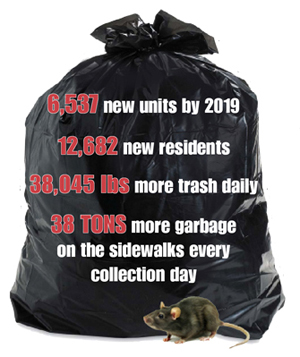 “That is going to pale in comparison to what’s going to happen in the next two or three years,” said realtor Luis Vazquez, founder of the Fidi Fanpage on Facebook.
“That is going to pale in comparison to what’s going to happen in the next two or three years,” said realtor Luis Vazquez, founder of the Fidi Fanpage on Facebook.
According to estimates by Vazquez and CB1 staff, 44 new Downtown residential developments including as many as 6,537 units are expected to be completed by the end of 2018.
The average household size in Lower Manhattan is 1.94 people, according to CB1, and the average Downtowner generates about three pounds of household garbage a day, including recycling, based on census figures and city trash-collection statistics. So the residential developments expected between now and 2018 will produce more than 19 tons of additional household trash daily.
And since residential garbage is collected only three days a week, that means Downtowners will have to find a way to share their sidewalks with another 38 tons of refuse every collection day.
“Just thinking about that makes me want to pack my bags,” said Elbatanouny.
The Dept. of Sanitation has already nearly doubled the number of trucks hauling household garbage out of CB1 since 2006, from 14 to 25, according to the city. But ramping up collection service again to deal with a comparable rise in refuse presents particular challenges Downtown, where the streets and sidewalks are significantly narrower than in the grid layout further north.
In most of Manhattan, the avenues are at least 60 feet wide, and cross streets run about 30 feet across, with both typically flanked by generous 15-foot sidewalks. But Downtown’s William St., for example, is only 14 feet across, and the sidewalks are just 11 feet wide.
The 188-unit condo building slated for 130 William St. may find space on its 11-foot sidewalk for the ton of trash its residents will need to put out on the curb for pick-up, but other Downtown developments will face far bigger challenges.
The conversion of 70 Pine St. into luxury residences will bring 644 new units to one of the tightest corners of Fidi — along with nearly two tons of daily household trash — meaning that each collection day, more than 3.7 tons of garbage will have to be piled up on some of the narrowest sidewalks in the city.
The sidewalk along Pine St. is barely more than nine feet wide, while at the back of the building along Cedar St. it’s a scant 7.5 feet from wall to curb. The Pearl St. side of the building does afford about 11 feet of space, but that frontage is only 106 feet long, just about half the length of a north-south short block on the grid.
The management for 70 Pine would not discuss its plans for dealing with its trash.
“It’s scary,” said Moore. “But this is what you get when we allow developers to just build whatever they want.”
MORE RATS OR A SINKING SHIP
As dire as this impending garbage glut may seem, there could be one thing that might spare Downtown from becoming a hot mess — a cool down of the high-end real estate market.
Even as sales and prices of Downtown condos led the market in recent months, reports have multiplied that the market may have already reached its peak and could be heading for a slowdown.
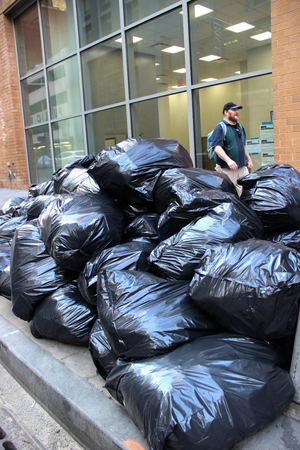
Mountains of garbage bags like this one outside 8 Spruce St. will become an ever more common fixture of Downtown sidewalks if the current residential boom continues apace.
“Last year was a great year, but as we progressed we began to see some cracks emerging,” Cushman’s head of property sales Bob Knakal told Crain’s.
The Federal Reserve’s “Beige Book” of regional economic conditions noted in December that “some weakening is reported at the high end of New York City’s co-op and condo market, reflecting both softer demand and a supply glut.”
One of the dirty little secrets of Manhatan’s high-end housing boom is that a good number of the priciest condos are being snapped up by the likes of Russian oligarchs and Chinese billionaires to serve essentially as well-appointed self-storage lockers for ill-gotten gains.
But increased scrutiny by federal authorities of wealthy foreign buyers is weakening one of the main sources of demand for the pricey condos driving the Fidi residential boom, and some sellers are already resorting to deep discounts to move their ever-increasing inventory, making new developments less profitable.
If that trend continues, many of the priciest units currently in the pipeline may remain unoccupied for years to come, and some of the more ambitious projects on the far horizon could be delayed, scaled back, or even abandoned entirely.
So if the penthouse archipelago now rising above Lower Manhattan ends up as just a constellation of desert islands, then the sidewalks of Downtown may well be spared the fate of becoming a high-rent version of a mid-ocean garbage patch.
Otherwise, Downtowners had better get ready to dodge more rats as they navigate ever-deepening canyons of trash.
